There were 3 posts tagged: Y-cord
All-In-One Headsets Explained

The term "all-in-one" brings to mind 2-in-1 Shampoo and Conditioner, sporks, and other consumer products. Dictionary. com defines "all-in-one" as something that combines two or more items or functions in a single unit. The very term implies simplicity.
When applied to headsets, the term all-in-one refers to the headset and the USB call control unit together forming a single solution that does not require an additional piece for functionality.
 For USB connection, there are two types of corded headsets: Quick Disconnect (QD) and All-in-One. Quick Disconnect headsets end in a proprietary connector and require a QD cable to USB adapter cable for softphone. All-in-one USB headsets plug directly into a USB port. Call controllers are standard in these all-in-one solutions,
For USB connection, there are two types of corded headsets: Quick Disconnect (QD) and All-in-One. Quick Disconnect headsets end in a proprietary connector and require a QD cable to USB adapter cable for softphone. All-in-one USB headsets plug directly into a USB port. Call controllers are standard in these all-in-one solutions, 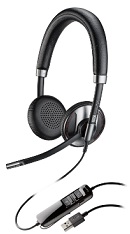 for user-friendly one-touch call answer/end, mute, and volume.
for user-friendly one-touch call answer/end, mute, and volume. 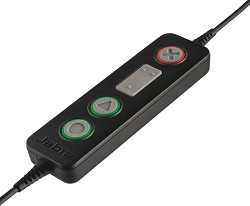 There are benefits to all-in-one headsets: easier inventory management (1 piece rather than 2 or more); easy distribution to staff; and set up on softphones can be controlled from the IT Manager's desk, depending upon which brand of headset is used. One issue that must be examined is how side by side training and monitoring will take place. All-in-one USB headsets DO NOT allow a second headset to plug in anywhere. You must use QD setups for training which allow two headsets to be connected to one station.
There are benefits to all-in-one headsets: easier inventory management (1 piece rather than 2 or more); easy distribution to staff; and set up on softphones can be controlled from the IT Manager's desk, depending upon which brand of headset is used. One issue that must be examined is how side by side training and monitoring will take place. All-in-one USB headsets DO NOT allow a second headset to plug in anywhere. You must use QD setups for training which allow two headsets to be connected to one station. Here are some of the training set-ups that we recommend to our customers: 2 QD headsets used with a standard QD Y-cord and a QD to USB connector cable; wireless headsets; or when using Jabra headsets, 2 QD headsets, with a Link 265 USB Y-cord.
Contact us today for help determining the very best headsets for your environment and budget: 1-866-998-9991.
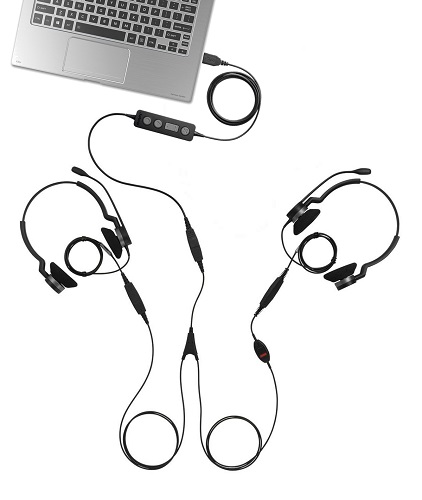
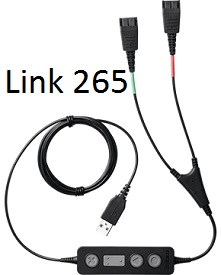
Transition to Softphones and USB Headsets
At Avcomm Solutions, one of the benefits of our jobs is speaking with our customers. Your questions, ideas, and challenges keep us on our toes, and ensure that we continue to find the best ways to serve you. In the past year or more, we have noticed an increased number of our customers are swapping out desk phones for softphone solutions – most especially in contact center environments. And we all know the cost of replacing telephony equipment/software, coupled with the cost of hardware, can be a huge expense. Regarding these environments, almost always the question we hear is: “Can we keep our existing QD headsets?”
Our answer: “absolutely!”
 All of our headset manufacturers (Jabra, Sennheiser, Plantronics and VXi) offer USB adapters that connect to PCs via USB; some of the brands additionally offer amplifiers. You can use your existing Quick Disconnect headsets when you purchase a USB adapter that simply plugs into a USB port in your PC, and then connects to the headset with the QD connection. The adapters and amplifiers provide additional noise technologies for clear calls.
All of our headset manufacturers (Jabra, Sennheiser, Plantronics and VXi) offer USB adapters that connect to PCs via USB; some of the brands additionally offer amplifiers. You can use your existing Quick Disconnect headsets when you purchase a USB adapter that simply plugs into a USB port in your PC, and then connects to the headset with the QD connection. The adapters and amplifiers provide additional noise technologies for clear calls.
Depending upon the features your company wants to provide for its staff, simple USB adapters (QD to USB) are fairly inexpensive and run anywhere from $30-$70.
You will pay more for features such as call answer/end, volume, and mute control, but this offers a more user-friendly experience for your customer representatives. Your staff would be able to use the touch buttons on the device, rather than using softkeys on their PCs.
Amplifiers that are USB compatible provide noise protections, better sound quality and, depending upon the manufacturer, premium features that include voice recording.
Software updates for the USB devices are offered free of charge from each manufacturer. These updates enable USB devices to have Remote Call Control over softphones (specific softphones supported are manufacturer dependent), bring features to personalize the device, and can also update status.
These USB adapters and amplifiers are great for hot desking and multiple shift environments; each representative can have their own headset, and connect to the PC at the desk they’re assigned to work at that day. At the end of their shift, they can detach the headset and walk away. The PC is ready for the next employee to use.
An advantage of using your existing quick disconnect headsets when transitioning to softphones is the ability to continue doing side by side training utilizing your training Y cables. When planning your softphone rollout, be sure to keep in mind how certain day to day tasks, such as side by side training, might be affected. Some companies choose to update their headsets at the time of a softphone rollout and go with all-in-one USB solutions, which leave no option of side by side training. In that case, a separate training setup must be purchased, which adds to your list of product you have to manage.
Once an overall plan has been determined, the transition to softphones can be easily accomplished. Do you have questions about how to transition your current headsets to a softphone environment? We will discuss the process with you (providing helpful, brand-specific advice along the way!) and provide options. If desired, we can provide a quote specifically tailored to your organization. Contact us today!
Our answer: “absolutely!”
 All of our headset manufacturers (Jabra, Sennheiser, Plantronics and VXi) offer USB adapters that connect to PCs via USB; some of the brands additionally offer amplifiers. You can use your existing Quick Disconnect headsets when you purchase a USB adapter that simply plugs into a USB port in your PC, and then connects to the headset with the QD connection. The adapters and amplifiers provide additional noise technologies for clear calls.
All of our headset manufacturers (Jabra, Sennheiser, Plantronics and VXi) offer USB adapters that connect to PCs via USB; some of the brands additionally offer amplifiers. You can use your existing Quick Disconnect headsets when you purchase a USB adapter that simply plugs into a USB port in your PC, and then connects to the headset with the QD connection. The adapters and amplifiers provide additional noise technologies for clear calls.Depending upon the features your company wants to provide for its staff, simple USB adapters (QD to USB) are fairly inexpensive and run anywhere from $30-$70.
You will pay more for features such as call answer/end, volume, and mute control, but this offers a more user-friendly experience for your customer representatives. Your staff would be able to use the touch buttons on the device, rather than using softkeys on their PCs.
Amplifiers that are USB compatible provide noise protections, better sound quality and, depending upon the manufacturer, premium features that include voice recording.
Software updates for the USB devices are offered free of charge from each manufacturer. These updates enable USB devices to have Remote Call Control over softphones (specific softphones supported are manufacturer dependent), bring features to personalize the device, and can also update status.
These USB adapters and amplifiers are great for hot desking and multiple shift environments; each representative can have their own headset, and connect to the PC at the desk they’re assigned to work at that day. At the end of their shift, they can detach the headset and walk away. The PC is ready for the next employee to use.
An advantage of using your existing quick disconnect headsets when transitioning to softphones is the ability to continue doing side by side training utilizing your training Y cables. When planning your softphone rollout, be sure to keep in mind how certain day to day tasks, such as side by side training, might be affected. Some companies choose to update their headsets at the time of a softphone rollout and go with all-in-one USB solutions, which leave no option of side by side training. In that case, a separate training setup must be purchased, which adds to your list of product you have to manage.
Once an overall plan has been determined, the transition to softphones can be easily accomplished. Do you have questions about how to transition your current headsets to a softphone environment? We will discuss the process with you (providing helpful, brand-specific advice along the way!) and provide options. If desired, we can provide a quote specifically tailored to your organization. Contact us today!
Introducing the Jabra LINK 265, a first in class USB training Y-cord
The Jabra LINK 265 is a brand new USB connection Y-training cable that boosts productivity and streamlines the equipment needed for training. This is a unique product in the market for training purposes. Not only does it allow two Jabra Quick Disconnect (QD) style headsets to connect to one PC, but it also provides inline volume and mute control, as well as customization of buttons based upon user preference. Call center agents, trainers, and supervisors alike will appreciate the ease of use of the LINK 265.
*Please note that the "X" and triangle buttons are programmable and can be set according to your preference through PC Suite. The functionality of these programmable options is dependent upon the softphone that is being used. The first time you plug in the LINK 265 to the USB port on your computer, the three round buttons light up green. The audio-link status button turns to red and the others turn off.
You'll also notice that each side of the Y cord is tagged with a different color: green and red. The green side allows for voice transmission at all times and has the option of being muted. The red side is designed for the supervisor/trainer to connect to and is muted by default (red light around audio-link status button indicates mute). Should the supervisor need to activate or unmute their microphone, simply press and hold the audio-link status button on the LINK 265 for 1-2 seconds, until the light turns green. The supervisor is now live and able to join the conversation. To mute the supervisor's side again, hold the same button for 1-2 seconds, and the light will turn red.
Mute both headset microphones at the same time by pressing the Mute button.
Two additional features worth mentioning:
Your agents' safety is a priority for Jabra. The LINK 265 has Jabra SafeTone™, including Jabra PeakStop and Jabra IntelliTone™, the enhanced hearing protection technology. These technologies prevent stress and hearing injuries. The LINK 265 delivers acoustic shock protection and is compliant with the Noise at Work legislation in the EU.
If your organization is looking for workplace flexibility – such as hot desking – the LINK 265 is an ideal connector. Free and downloadable Jabra Direct and Jabra Xpress software allow you to set up and personalize devices in a minimal amount of time.
Here's a quick view at the many options that the LINK 265 programmable buttons offer through Jabra Direct:
We tested the LINK 265 using Vidyo, our in-house videoconferencing solution. During the call, we transitioned from one headset live, to two, and then back to one. The process was seamless. The lighted buttons are the perfect size – not too big, nor too small. The conversation was clear and voices were easy to hear. The LINK 265 passed our test with flying colors!
This USB training Y-cord streamlines the equipment needed for your training needs; provides inline call controls with the ability to toggle the mute microphone function between both headsets; and utilizes the no-cost Jabra Direct and Jabra Xpress software. Jabra packed this training Y-cord with functionality and compatibility, making this an easy choice for training with your PC softphones. Contact us for more information about the LINK 265!
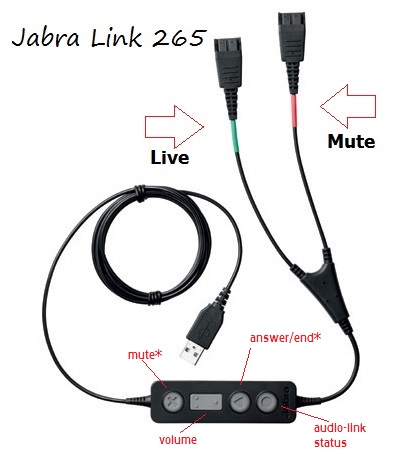
*Please note that the "X" and triangle buttons are programmable and can be set according to your preference through PC Suite. The functionality of these programmable options is dependent upon the softphone that is being used. The first time you plug in the LINK 265 to the USB port on your computer, the three round buttons light up green. The audio-link status button turns to red and the others turn off.
You'll also notice that each side of the Y cord is tagged with a different color: green and red. The green side allows for voice transmission at all times and has the option of being muted. The red side is designed for the supervisor/trainer to connect to and is muted by default (red light around audio-link status button indicates mute). Should the supervisor need to activate or unmute their microphone, simply press and hold the audio-link status button on the LINK 265 for 1-2 seconds, until the light turns green. The supervisor is now live and able to join the conversation. To mute the supervisor's side again, hold the same button for 1-2 seconds, and the light will turn red.
Mute both headset microphones at the same time by pressing the Mute button.
Two additional features worth mentioning:
- Digital Signal Processing (DSP) removes background noise and echo, as well as protects users against sudden high peaks in volume.
- HD Voice – Wideband Audio is high quality audio for crystal clear, intelligible conversations. Life-like, vibrant conversations help you to focus on the content of the conversation.
Your agents' safety is a priority for Jabra. The LINK 265 has Jabra SafeTone™, including Jabra PeakStop and Jabra IntelliTone™, the enhanced hearing protection technology. These technologies prevent stress and hearing injuries. The LINK 265 delivers acoustic shock protection and is compliant with the Noise at Work legislation in the EU.
If your organization is looking for workplace flexibility – such as hot desking – the LINK 265 is an ideal connector. Free and downloadable Jabra Direct and Jabra Xpress software allow you to set up and personalize devices in a minimal amount of time.
Here's a quick view at the many options that the LINK 265 programmable buttons offer through Jabra Direct:
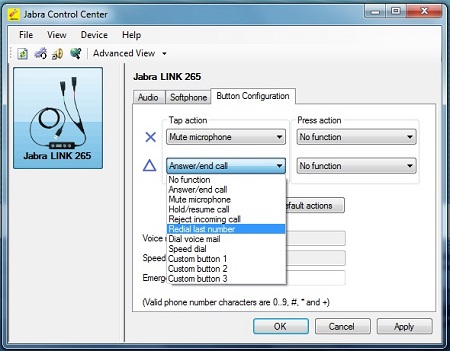
We tested the LINK 265 using Vidyo, our in-house videoconferencing solution. During the call, we transitioned from one headset live, to two, and then back to one. The process was seamless. The lighted buttons are the perfect size – not too big, nor too small. The conversation was clear and voices were easy to hear. The LINK 265 passed our test with flying colors!
This USB training Y-cord streamlines the equipment needed for your training needs; provides inline call controls with the ability to toggle the mute microphone function between both headsets; and utilizes the no-cost Jabra Direct and Jabra Xpress software. Jabra packed this training Y-cord with functionality and compatibility, making this an easy choice for training with your PC softphones. Contact us for more information about the LINK 265!

